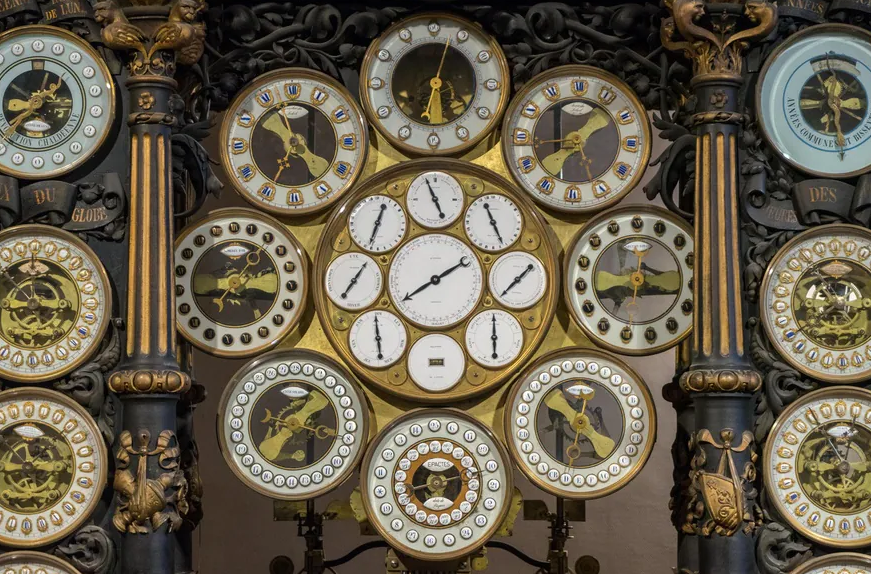
Part of the astronomical clock at the Cathédrale Saint-Jean de Besançon Philip Bird / Alamy Stock Photo
Just a short hop from the Swiss border, the walled city of Besançon is a showcase of centuries of French watchmaking knowhow.
Within its labyrinth of pristine streets are many secret courtyards, where, behind imposing doors, independent watchmakers carry forward its best-known traditions in what is considered France’s capital of watches.
The city’s biggest timekeeping attractions – the Musée du Temps, the Besançon Astronomical Observatory, and its most famous object, the astronomical clock at the Cathédrale Saint-Jean de Besançon – bring in visitors in search of its story.
The astronomical clock has 30,000 elements. Keeping the time in more than a dozen places around the world, and indicating the tides in eight French ports, it is designed, with its many small figurines, to re-enact the birth and resurrection of Christ.
In the Musée du Temps, timepieces and the stories of the individuals that have helped shape France’s watchmaking history are included in its displays. “The works of the great watchmakers Ferdinand Berthoud and Antide Janvier stand alongside the deposits of prestigious institutions such as the Paris and Besançon observatories and the Bureau des Longitudes,” says curator Laurence Reibel.
The museum’s watchmaking treasure is the Leroy 01 which was produced in Besançon in 1904. For 80 years, it was “the most complicated watch in the world, thanks to its 24 functions”, Reibel says.
Local watchmaking traditions
Opposite the Musée du Temps lies the Utinam clock manufacture. Founded in 1996 by horologist Philippe Lebru, it is now one of the highest-profile companies carrying local watchmaking traditions forward.
Lebru was inspired by apprentices from a prestigious watchmaking school in the region, the Lycée Edgar Faure de Morteau, as well as retired watchmakers from Besançon’s iconic watchmaker Lip.
Lebru has created a modern version of the traditional Comtoise clock, featuring long hourglass shaped cases, made from brushed stainless steel.
“The traditional Grandfather clock is the village clock,” he says. “It has been giving the time in homes for three centuries. The French Comtoise version is known internationally as the grandfather clock. I redesigned it as a contemporary work by improving the weight and balance system with a patent – the suspended movement with automatic balancing system. The mechanics are exposed and become the signature of my creations. It is built like a drawing that speaks to the one who looks at it like a clock that lives with our times,” he says.
Utinam has two in-house apprentices and two student engineers whom you can see working from the street. Local brands such as Humbert Droz, Berthet, Mat watches and Fob make an appearance inside the manufacture.
Other local brands include Lornet Watches. Its La Lornet LA-02 timepiece is, the firm says, the only watch developed, assembled and produced entirely in France.
Ups and downs
The city has seen its ups and downs from its heyday around the turn of the century. In 1904, it produced its most famous piece, the Leroy 01. Master clockmaker Basile Charles Le Roy, whose clients included Napoleon and Queen Victoria, had moved his L Leroy workshops from Paris to Besançon in 1892.
In 2004, Miguel Rodriguez, owner of Swiss watch brand Festina-Lotus, bought the L Leroy brand and re-established it in Besançon.
France’s most famous watch brand, Lip Watches, was founded in Besançon in 1867. It produced about ten million watches and was the timekeeper of the Tour de France during the 1950s. Lip closed its doors in 1977 until French businessman Jean-Claude Sensemat acquired the brand in 1990. He has rebuilt the business reissuing classic designs, including models worn by president Charles de Gaulle.
Well-known international brands located in Besançon include Seiko, Swatch, Tissot, Longines, Audemars Piguet, and Breitling – all of which operate service centres in or around the city.
The watchmaking and jewellery sector represents 5,000 jobs in the city today. There are also half a dozen watchmaking schools in the area. “Our schools and research laboratories are able to make proposals to the major luxury brands in the development of innovation, new marketing and distribution methods (luxury watch purchasing platforms) that we have already mastered in our territory,” says Pierre Dieterle, the economic director for greater Besançon.
And the city, he says, has an edge over its watchmaking neighbour. “Services like upstreaming, particularly in materials, systems or design, or downstreaming like aftersales service, marketing, logistics, are not currently covered in Switzerland because they are saturated,” he says. “They are being developed in Besançon Metropole instead.”
Copyright The Financial Times Limited 2021
Full story here Are you the author? Previous post See more for Next postTags: Featured,newsletter,Sci & Tech





























